For a special occasion dinner option, garlic rosemary beef tenderloin is the best! Seared in a cast iron skillet for a caramelized crust, then finished off in the oven on low heat, this tender beef melts in your mouth.
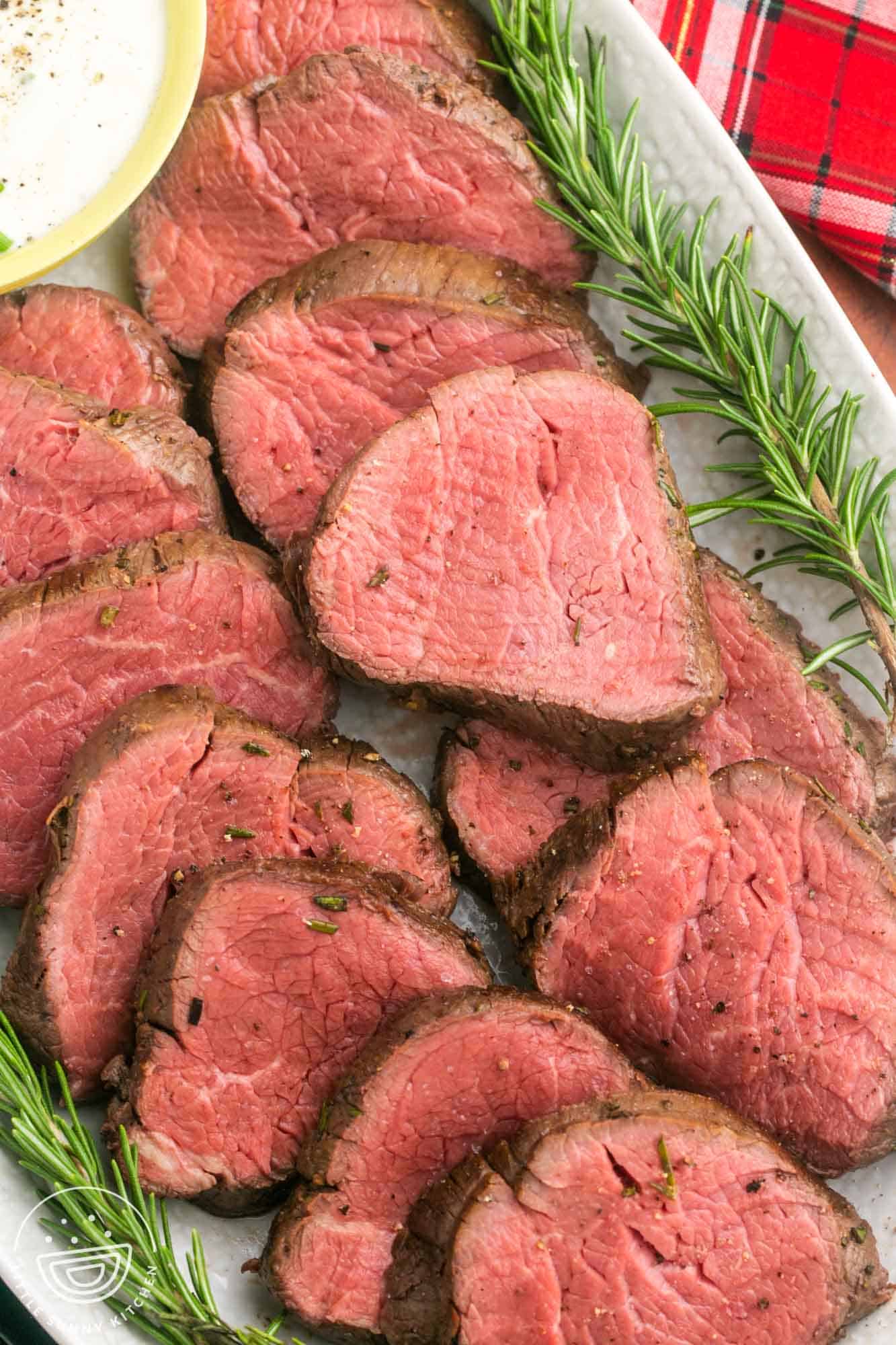
Holiday dinners and other special occasions call for something a little more elegant and this succulent roasted beef tenderloin with a garlic rosemary crust is a real showstopper.
Even though it sounds fancy, it’s very easy to prepare which means you can enjoy serving something impressive all the while knowing that it didn’t take much effort in the kitchen. Don’t worry, it will be our little secret!
Like prime rib, which is another great option for entertaining, beef tenderloin is roasted at a very low temperature, but instead of taking 3 hours like the prime rib, tenderloin cooks very quickly in about 30 minutes.
Served alongside some mashed potatoes and horseradish sauce, this is a dish you will be proud to serve to your guests!
What is Beef Tenderloin?
When you’re looking for something a little fancier to serve for your main course, beef tenderloin is the way to go!
You might have heard it referred to by a few different names: beef tenderloin, beef fillet, or filet mignon roast. Whatever you know it as, it is the most tender cut of beef available with a lovely mild flavor which makes it one of the most coveted cuts of meat.
Because it’s considered a prime cut, it also comes with a bit of a heftier price tag, but it’s worth the splurge for special occasions!
The tenderloin is a long cylinder shape and comes from lean muscle near the backbone of the cow. It is soft and buttery with very little marbling if any, so it cooks up very quickly and practically melts in your mouth. It’s also super easy to carve into individual slices.
Usually, whole tenderloins are sold as either unpeeled with the fat and silverskin attached, peeled with the fat removed and the silverskin intact, or peeled with the silverskin removed and the chain left on or off. The chain is a fatty narrow strip of side muscle that is usually removed before cooking.
If you’re buying your tenderloin from the butcher, they can peel it and remove the silverskin and chain for you. Some butchers will also tie it for you.
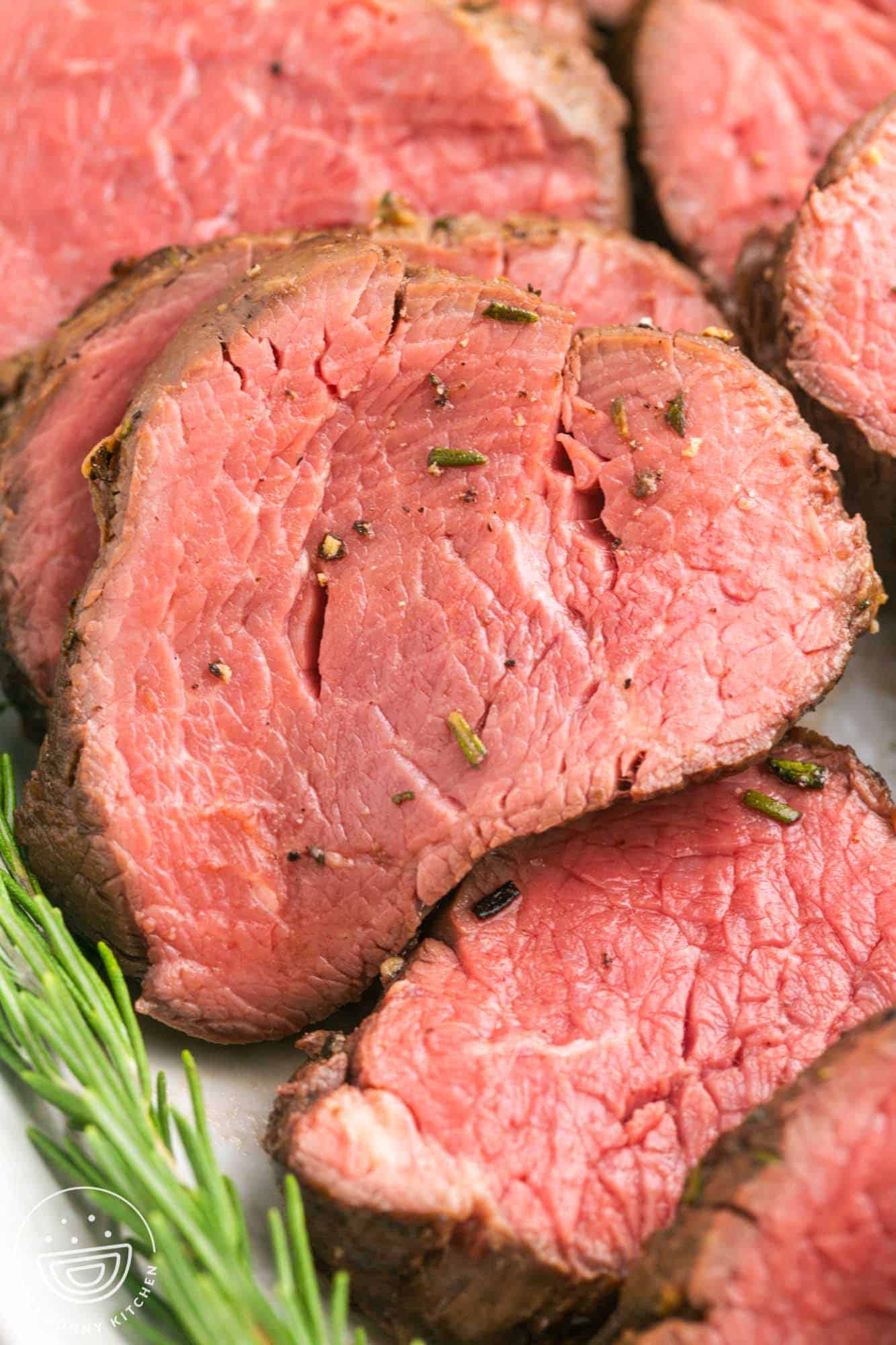
Why You’ll Love This Recipe
- It’s quick and easy: Fancy doesn’t have to mean complicated! Beef tenderloin roast is so easy with minimal prep and a quick cooking time.
- Ultimate flavor: This tenderloin is tender and mild in flavor, with a nice brown crust.
- Impressive: This dish is perfect for holidays and dinner parties.
key ingredients
Here’s what you need to make this easy and impressive meal.
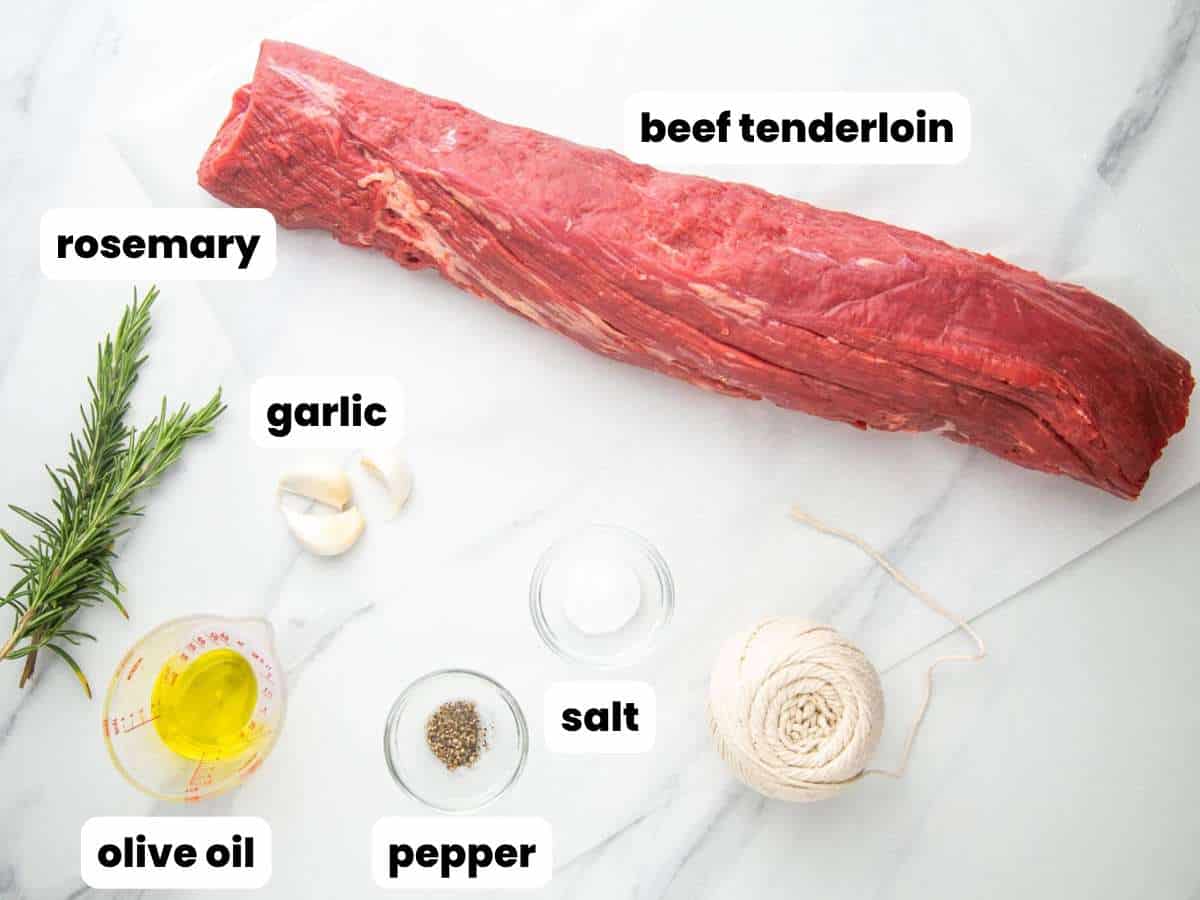
Complete list of ingredients and amounts can be found in the recipe card below.
- Beef tenderloin: Look for a 3–4 lb center cut and trim it if necessary. I bought mine at Costco and it came peeled with the chain off.
- Flavor: I kept it simple using just salt and pepper for seasoning and fresh rosemary, crushed garlic, and olive oil for the crust.
How to Prepare Beef Tenderloin
- Trim the tenderloin by using a small sharp knife to cut the silverskin off. The silverskin runs the length of the tenderloin and is pretty easy to remove. Run the knife under it and lift it with your other hand and it should pull off. Also, trim off any fat and remove the chain if there is one.
- Tie the tail of the beef fillet by tucking it under itself and using kitchen twine to secure it. This will ensure that the fillet cooks evenly (the tenderloin that you can see in my images did not come with a tail, so I didn’t have to tie it).
- *Optional* Chill the beef in the fridge after seasoning, uncovered, for up to 12 hours. Leaving it uncovered will help the tenderloin to dry out which will result in a better crust. If you’re leaving it in the fridge for longer than 12 hours, cover it with plastic wrap and continue to store it for up to 2 days.
How To Make Beef Tenderloin Roast
There’s not a lot of hands-on time when cooking beef tenderloin which leaves you plenty of time to prepare the rest of the meal!
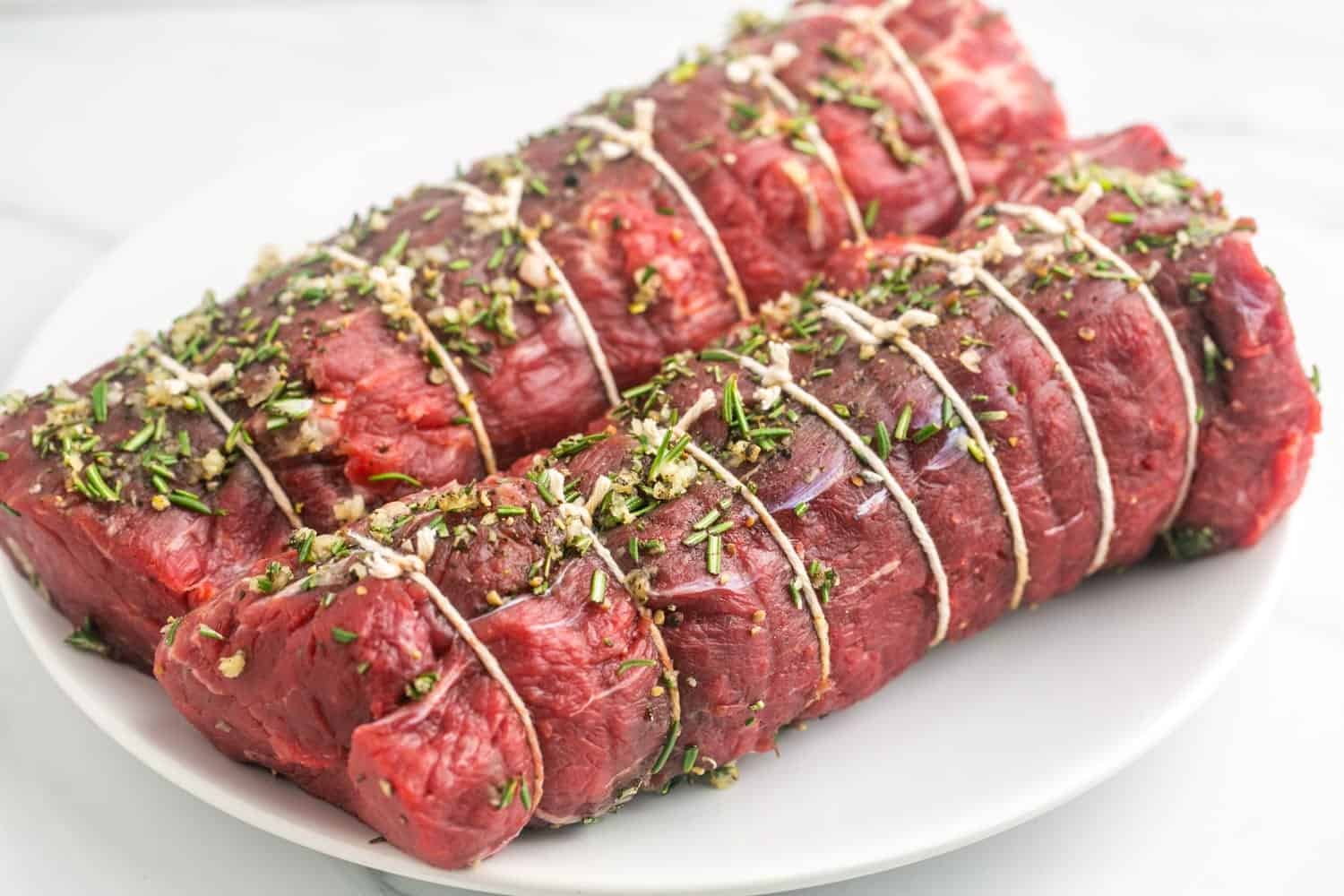
- Season the beef. Cut the tenderloin in half and season it evenly all over with salt and pepper. It’s very important to let the tenderloin sit at room temperature for one hour. The salt causes the muscle proteins to swell and ensures a juicy tenderloin.
- Prep the seasoning. Chop the rosemary leaves and mince the garlic and mix in a small bowl before rubbing it all over the outside of the roast.
- Tie the roast. It’s a pretty uniform cut of meat, but we will tie it with kitchen twine just so it cooks a little more evenly (after seasoning), and do double knots so it stays in place about 1 or 1.5 inches between ties, and trim off the long ends.
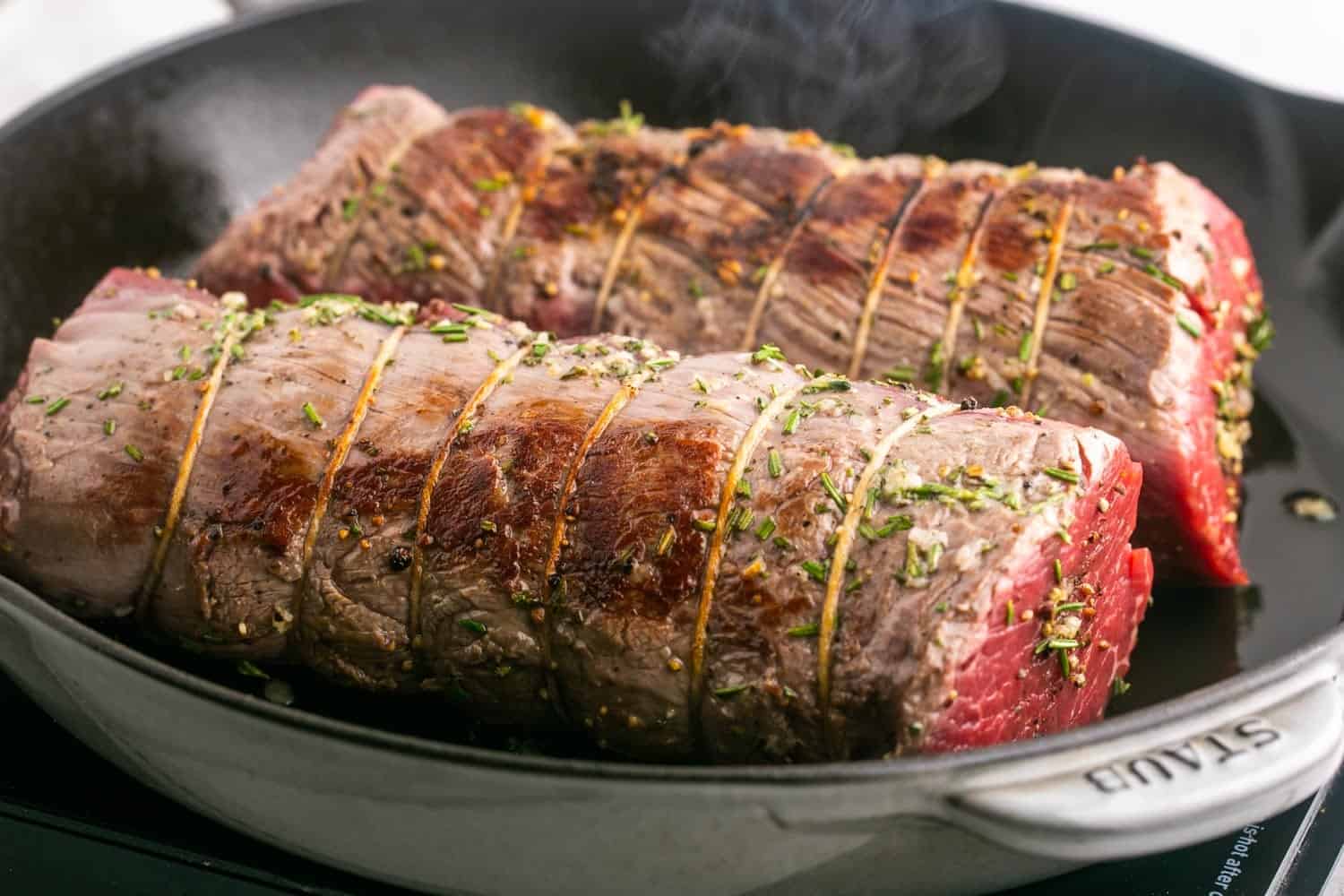
- Sear. Quickly sear all sides of the meat over medium-high heat in a skillet (I used cast iron). The meat should sizzle when you place it in the skillet, so you get a nice caramelized crust. This will take about 6–8 minutes.
- Roast. Transfer the tenderloin to a 240°F/120°C oven and cook for 25-30 minutes, turning every 10 minutes. Continue roasting until the internal temperature reaches 120°F/49°C for medium-rare.
- Make Horseradish Sauce. As you wait, quickly whip a delicious homemade Horseradish Sauce to serve with the beef tenderloin slices.
- Rest. Remove the meat from the oven and let it rest on a cutting board for 15 minutes before slicing. Remember to remove the kitchen twine with a pair of scissors before serving.
Tip!
If you have any guests or family members who insist on having it well done, I suggest cutting off a piece for them and cooking it a bit longer in a skillet.
Beef Tenderloin Temperatures
Tenderloin is a tender cut of meat, so you really don’t want to overcook it. For that reason, it is best served rare, medium-rare, or medium.
Remember that your meat will continue to cook for a few minutes during the resting phase after you bring it out of the oven from the residual heat, so it’s always a good idea to bring it out about 5 degrees below your ideal temperature.
Use your kitchen thermometer to check the internal temperature of the meat to ensure it’s where you want it to be.
Here are some temperature guidelines to follow:
- Rare: Remove the meat from the oven once it reaches 110°F. The final temperature should be around 115°F after the resting period. Look for the center of the tenderloin to be bright red with some pink around the very edges of the meat.
- Medium-rare: Remove the meat from the oven at 120°F and allow the meat to rest for a few minutes. The final temperature should be around 125°F. Look for the very center of the meat to me red becoming pinker the closer it gets to the edges.
- Medium: Remove the meat from the oven at 130°F. The rested meat should reach 135°F and the center should be pink and feel warm to the touch. The outer ring should be brown the closer it gets to the edges.
You’ll find that the medium-rare cuts are towards the center of the tenderloin while the end cuts will be closer to medium.
Recipe Tips
- Use a thin and flexible boning knife to remove the silver skin from the tenderloin.
- Tuck the tapered end of the tenderloin under itself so that the entire thing is the same thickness all the way around. This way everything will cook evenly.
- Remember that the beef tenderloin will continue to cook for a few minutes after it comes out of the oven, so remove it just before it reaches your desired doneness.
- Make sure to allow your meat to sit at room temperature for 1 hour after you season it. Salt draws out the moisture, so if you sear it right away, the moisture will evaporate, leaving you with a dry roast, rather than giving it a chance to settle back into the meat.
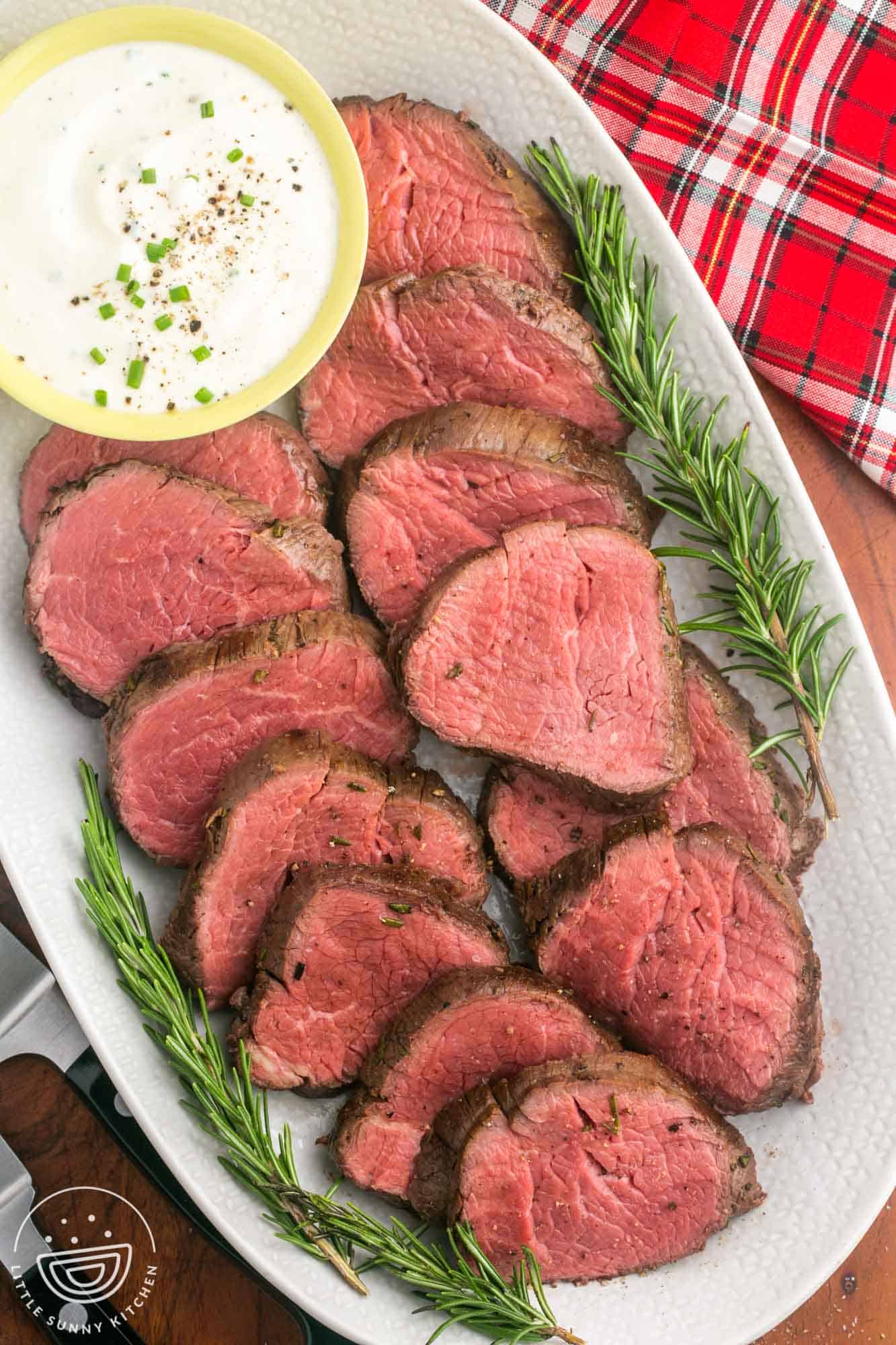
Storing Tips
Beef tenderloin roast is at its best when you eat it on the day it’s made, but if you have leftovers, you can store them to enjoy later in the week.
Refrigerator: Let the tenderloin cool completely and then place it in an airtight container for up to 5 days.
Reheating: You definitely don’t want to overcook this tender cut of beef, so be careful when reheating! Place slices of tenderloin in foil on a baking sheet and warm in a 350°F/180°C oven or heat the slices for 1 minute in the microwave.
What To Serve With
With a classy main dish, you want to be sure to pair it with some jazzed up sides!
First, don’t forget the Horseradish Sauce, it’s a must!
Easy Roasted Root Veggies, Boursin Mashed Potatoes, or Roasted Broccolini are a few of my favorites.
You could also serve it with Parsnip Puree, Sautéed Mushrooms and Onions, or a Simple Tossed Green Salad.
FAQs
Technically you don’t have to sear your tenderloin, but it’s a step I wouldn’t skip! When it comes to meat, a browned caramelized crust equals amazing flavor! You just won’t be able to get that same flavor if you simply roast the meat in the oven.
Beef tenderloin refers to the entire long cut of meat whereas filet mignon is cut from the smaller tip of the tenderloin. Both are extremely tender cuts and are often served on special occasions!
You want to allow for around half a pound of beef per serving, so 3–4 pounds should serve between 6–8 people.
Your family and friends are going to love this impressive garlic rosemary roast beef tenderloin! Pin it for more people to try!
Did you make this? Be sure to leave a review below and tag me on Facebook, Instagram, or Pinterest!
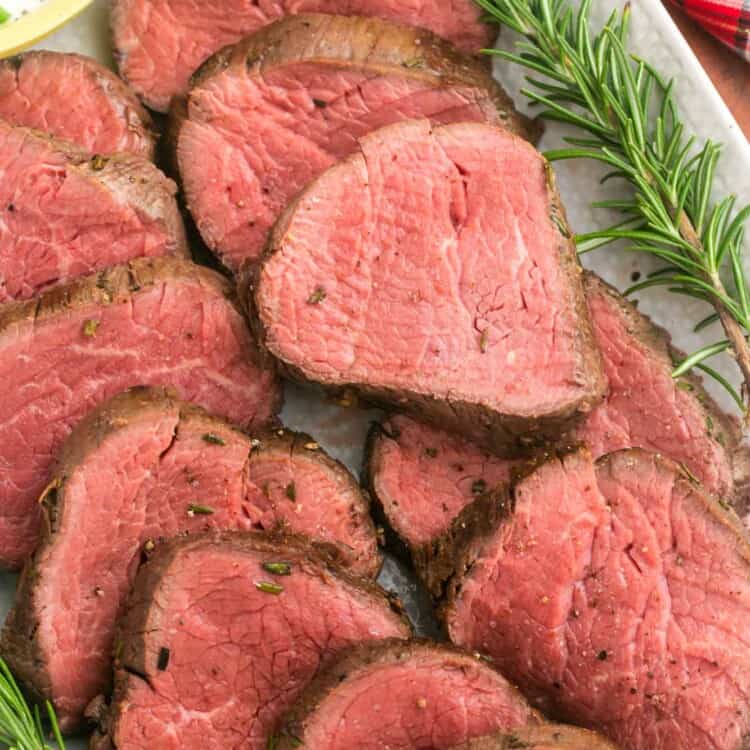
Beef Tenderloin Roast
Equipment
- Kitchen twine
Ingredients
- 3-4 lb (1.5-2kg) center cut trimmed beef tenderloin
- 2 teaspoons salt
- 1 teaspoon ground black pepper
- 2 tablespoons chopped fresh rosemary leaves and stalks
- 3 cloves garlic crushed or minced
- 1 tablespoon olive oil
Instructions
- Cut the tenderloin in half and season it evenly all over with salt and pepper. It's very important to let the tenderloin sit at room temperature for one hour. The salt causes the muscle proteins to swell and ensures a juicy tenderloin.
- As you wait, chop the rosemary leaves, peel and mince or crush the garlic. Mix them together and place them in a small bowl. Rub the mixture onto the roast.
- It’s a pretty uniform cut of meat, but we will tie it with kitchen twine just so it cooks a little more evenly (after seasoning), and do double knots so it stays in place about 1 or 1.5 inches between ties, and trim off the long ends.
- Preheat the oven to 240°F/120°C. Then heat oil in a skillet over medium high heat, and add the tenderloin pieces (you want to hear a shimmer when you place the meat, if you don’t, then you need to heat it up a little more. Do a quick sear from all sides (6-8 minutes).
- Then transfer to the oven and cook for 25-30 minutes turning every 10 minutes, until the internal temp of the thickest part of the meat is 120°F/49°C.
- Remove from the oven, and transfer beef tenderloin to a cutting board and allow to rest for 15 minutes before slicing. As you wait, make horseradish sauce. Remove the kitchen twine with a pair of scissors. Slice and transfer to a platter, and serve.
Notes:
- Use a thin and flexible boning knife to remove the silver skin from the tenderloin.
- Tuck the tapered end of the tenderloin under itself so that the entire thing is the same thickness all the way around. This way everything will cook evenly
- Rare: Remove the meat from the oven once it reaches 110°F. The final temperature should be around 115°F after the resting period. Look for the center of the tenderloin to be bright red with some pink around the very edges of the meat.
- Medium-rare: Remove the meat from the oven at 120°F and allow the meat to rest for a few minutes. The final temperature should be around 125°F. Look for the very center of the meat to me red becoming pinker the closer it gets to the edges.
- Medium: Remove the meat from the oven at 130°F. The rested meat should reach 135°F and the center should be pink and feel warm to the touch. The outer ring should be brown the closer it gets to the edges.
- You’ll find that the medium-rare cuts are towards the center of the tenderloin while the end cuts will be closer to medium.
- Remember that the beef tenderloin will continue to cook for a few minutes after it comes out of the oven, so remove it just before it reaches your desired doneness.
- Make sure to allow your meat to sit at room temperature for 1 hour after you season it. Salt draws out the moisture, so if you sear it right away, the moisture will evaporate, leaving you with a dry roast, rather than giving it a chance to settle back into the meat.
- Storing: Let the tenderloin cool completely and then place it in an airtight container in the fridge for up to 5 days.
Nutrition Information
This website provides approximate nutrition information for convenience and as a courtesy only. Nutrition data is gathered primarily from the USDA Food Composition Database, whenever available, or otherwise other online calculators.
© Little Sunny Kitchen
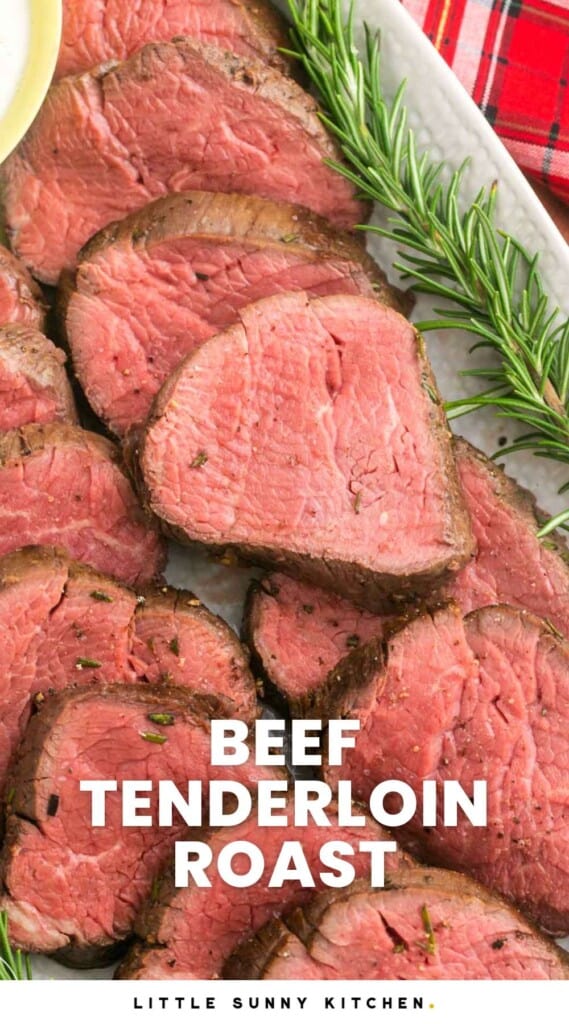
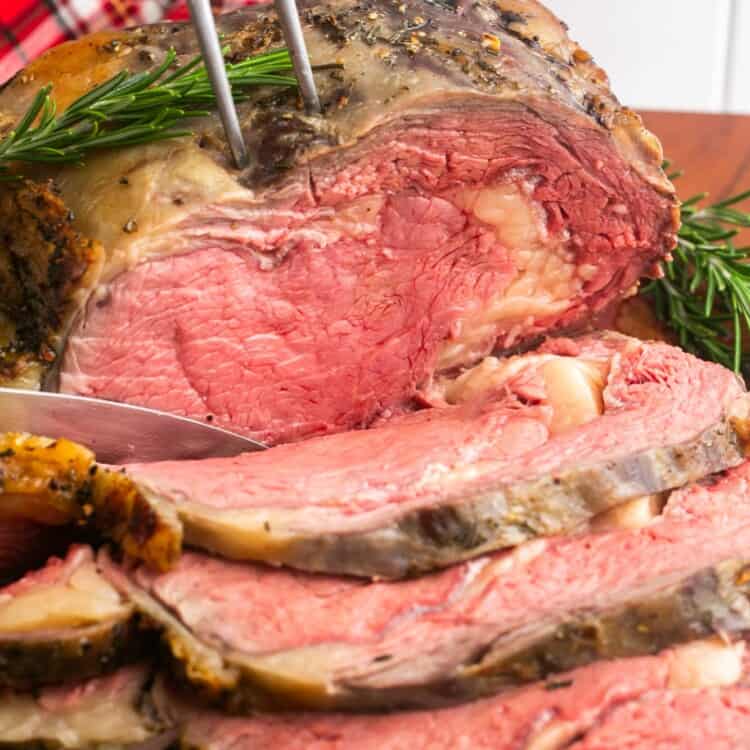
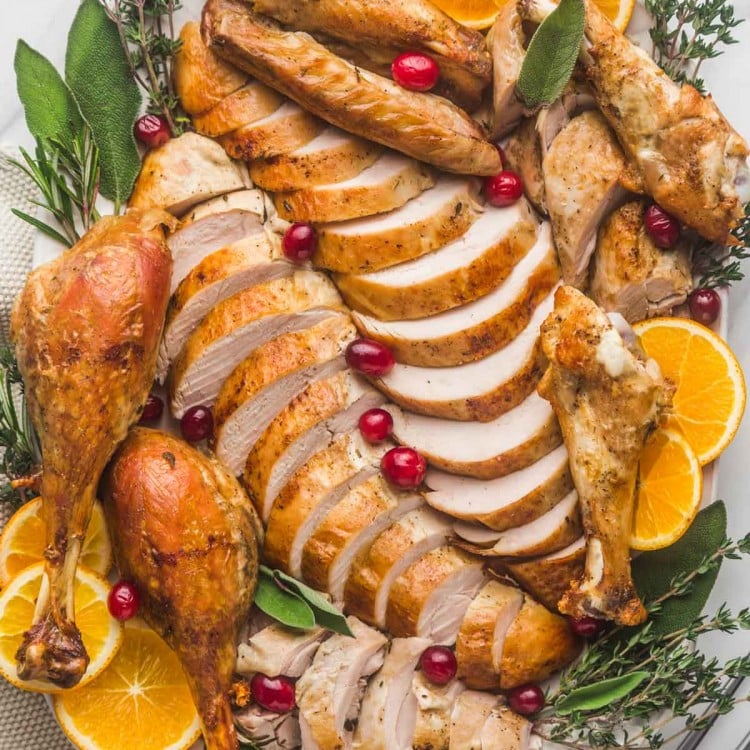
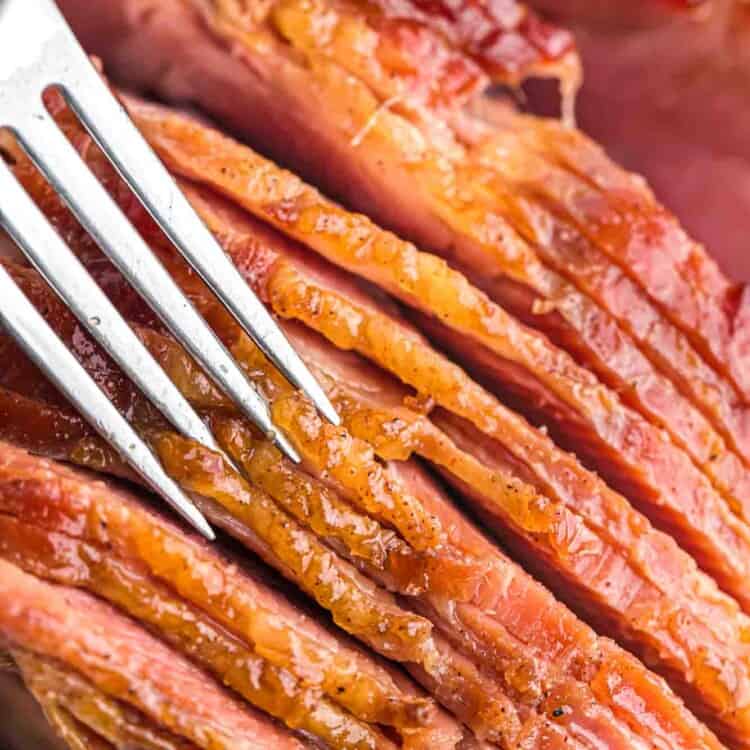
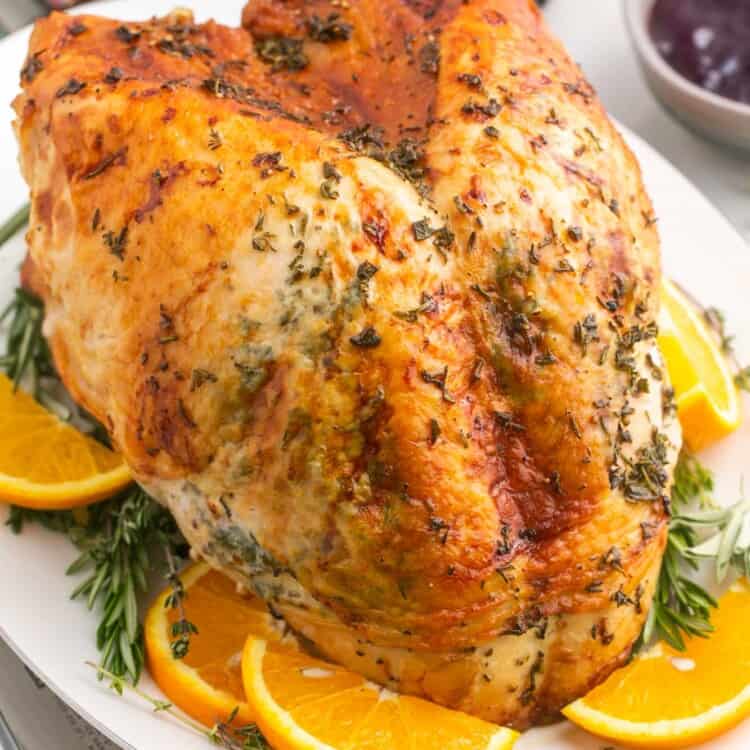
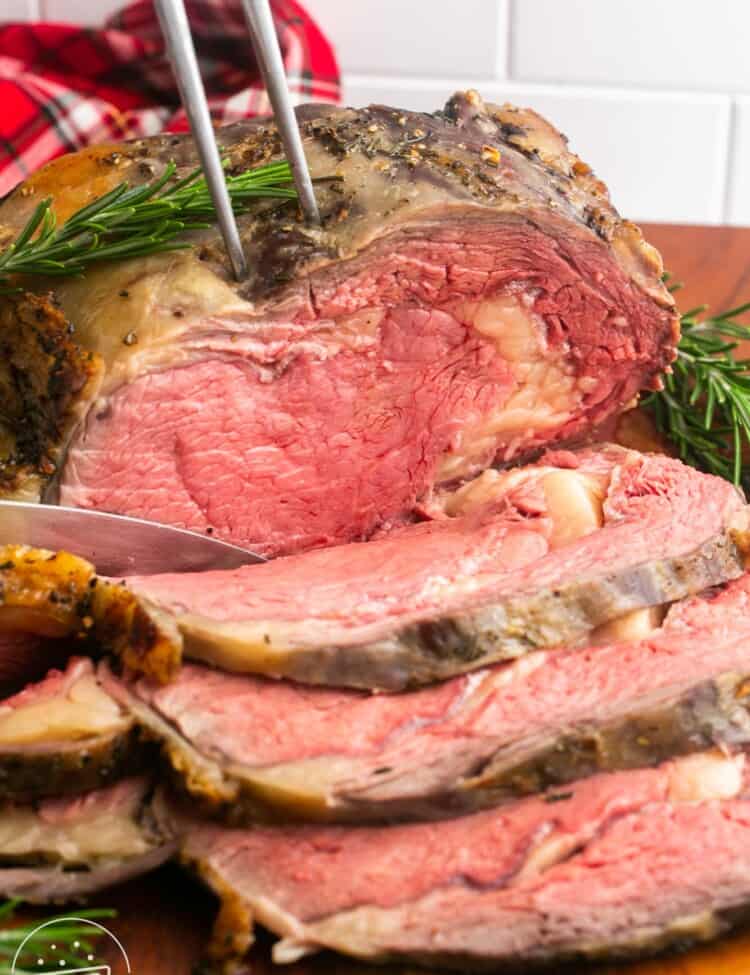

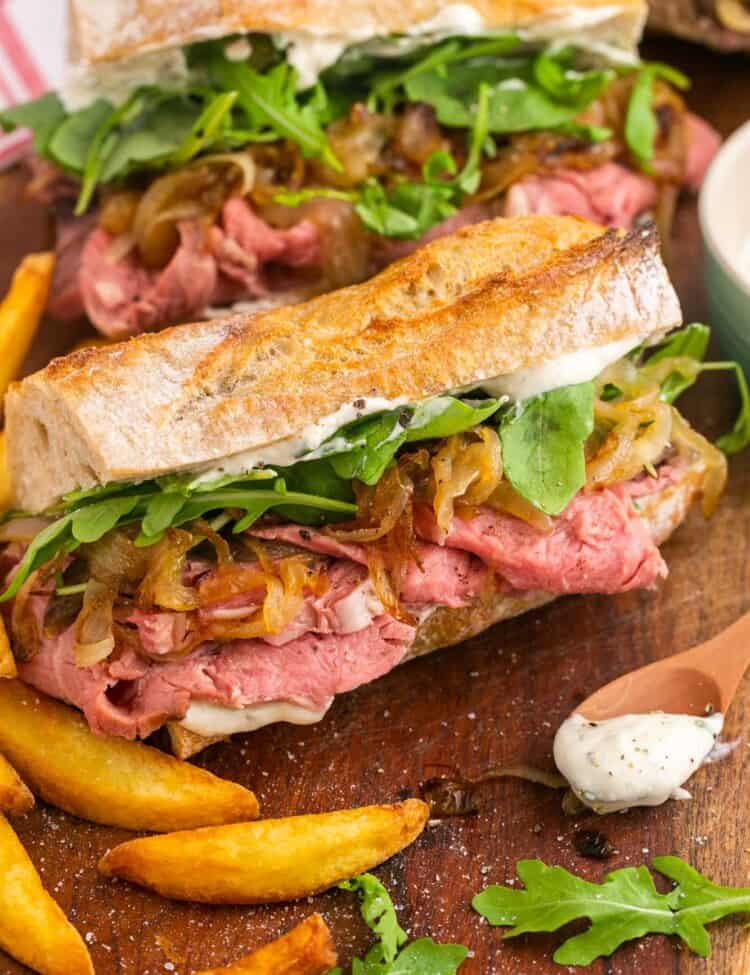
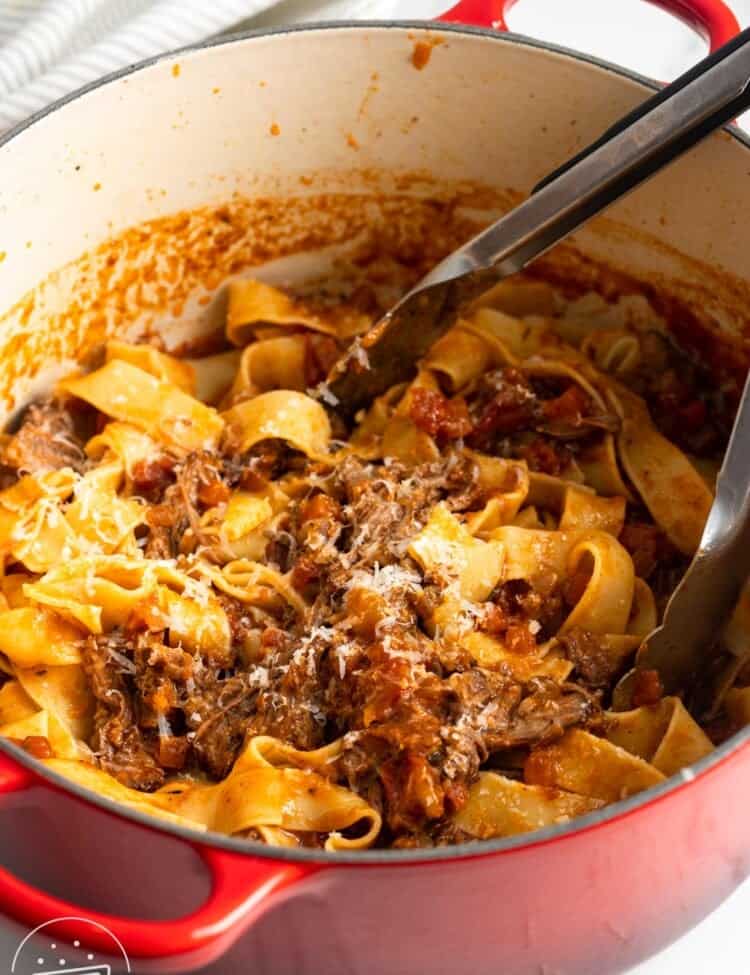


Leave a Review!